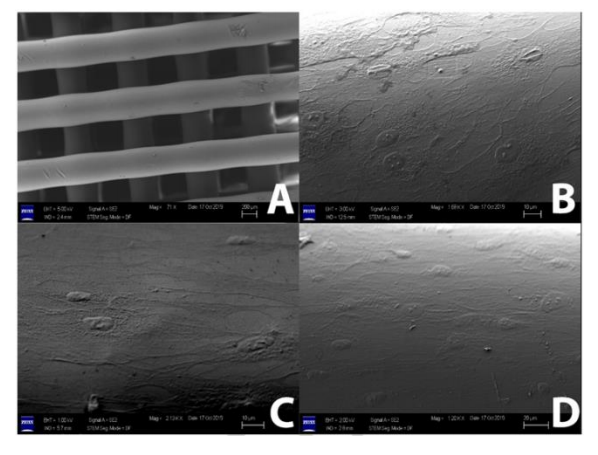Researchers in Turkey are 3D printing with PLA in a new study regarding human dermal fibroblasts and tissue engineering of skin cells. Their new findings are outlined in ‘3D Printed Polyactic Acid Scaffold for Dermal Tissue Engineering Application: The Fibroblast Proliferation in vitro,’ as the team from Dokuz Eylul University experimented with two different pore sizes while seeding HDFs.
Tissue engineering of skin cells could lead to critical breakthroughs for new methods of wound healing. As in most forms of tissue engineering, the researchers use bioprinted scaffolding as structures to nurture cell growth, serving as a substitute for the human extracellular matrix (ECM). For healing, the goal is for fibroblasts to infiltrate a wound with ECM proteins, and in some cases to act as drug delivery systems.
Scaffolds must be biocompatible, biodegradable, and possess suitable mechanical properties for performance in an area where the challenge of keeping cells alive can be a formidable one. PLA is a common material for creating scaffolds due to all of the same qualities necessary for scaffolds and is often used in biomedical applications that embrace its antibacterial elements, as well as introducing it into composites for bone regeneration, repairing of fractures, and much more.
Scaffolds for the study were fabricated with two different filling rates, designed in SolidWorks.
“Porous scaffolds were printed layer-by-layer in the form of squares surrounded by a dense PLA perimeter,” explained the researchers. “We determined the optimal speed of 15 mm/s for the filling speed and 25 mm/s for the gap speed. The travel speed of the extruder was set to be 100 mm/s. We fabricated scaffolds with two different pore sizes (35% and 40%).”
The scaffolds, seeded with cells, were then cultured over 12, and 18 days, with the greatest proliferation occurring on those days, demonstrating to the researchers not only that density is deeply tied to that activity, but also that pore sizes of 35 percent and 40 percent had no impact.

SEM images of A) PLA scaffold B) HDFs on the scaffold, 40% porosity and 4×104 cell/well C) HDFs on the scaffold, 40% porosity and 3×104 cell/well D) HDFs on the scaffold, 35% porosity and 4×104 cell/well
“Since HDFs continue to attach on the scaffolds on the 12th and 18th days, 3D printed PLA scaffolds are still confirmed to be biocompatible and safe in the longer period,” concluded the researchers.
“Our in vitro biocompatibility results of PLA scaffolds demonstrated that the microenvironment formed within the scaffolds is suitable and sufficient for the cells to preserve their viability, which is crucial for tissue engineering. Further studies in humans and animals are recommended for further assessment of the mechanical performance of the designed scaffolds containing fibroblast cells. In future studies, to obtain more evidence about the properties of 3D scaffolds to improve tissue regeneration, these 3D scaffolds will be evaluated in a context that mimics a clinical feature using the wound healing model in diabetic rats in vivo.”
What do you think of this news? Let us know your thoughts! Join the discussion of this and other 3D printing topics at 3DPrintBoard.com.
[Source / Images: ‘3D Printed Polyactic Acid Scaffold for Dermal Tissue Engineering Application: The Fibroblast Proliferation in vitro’]Subscribe to Our Email Newsletter
Stay up-to-date on all the latest news from the 3D printing industry and receive information and offers from third party vendors.
You May Also Like
Profiling a Construction 3D Printing Pioneer: US Army Corps of Engineers’ Megan Kreiger
The world of construction 3D printing is still so new that the true experts can probably be counted on two hands. Among them is Megan Kreiger, Portfolio Manager of Additive...
US Army Corps of Engineers Taps Lincoln Electric & Eaton for Largest 3D Printed US Civil Works Part
The Soo Locks sit on the US-Canadian border, enabling maritime travel between Lake Superior and Lake Huron, from which ships can reach the rest of the Great Lakes. Crafts carrying...
Construction 3D Printing CEO Reflects on Being Female in Construction
Natalie Wadley, CEO of ChangeMaker3D, could hear the words of her daughter sitting next to her resounding in her head. “Mum, MUM, you’ve won!” Wadley had just won the prestigious...
1Print to Commercialize 3D Printed Coastal Resilience Solutions
1Print, a company that specializes in deploying additive construction (AC) for infrastructure projects, has entered an agreement with the University of Miami (UM) to accelerate commercialization of the SEAHIVE shoreline...
































